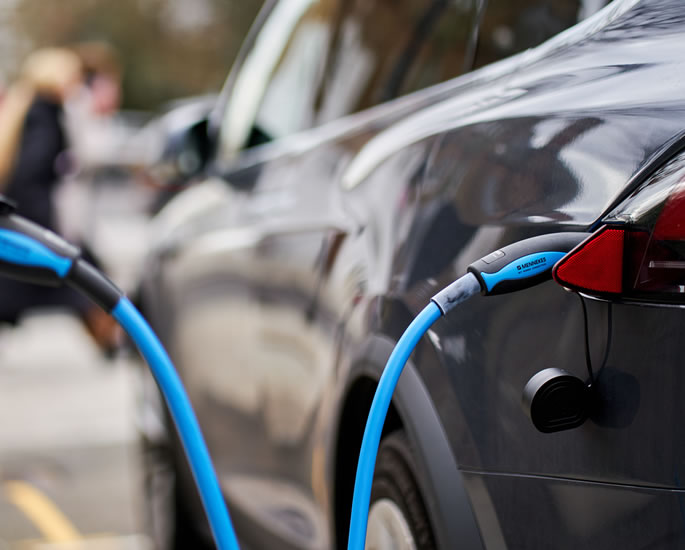The range of an EV depends on the car's battery
A few years ago, electric cars were much more expensive than their combustion engine counterparts.
But each year, electric vehicles (EVs) are becoming more popular, with more manufacturers producing them.
Rishi Sunak announced that the ban on new petrol and diesel cars would be delayed until 2035.
But some manufacturers remain committed to the original 2030 deadline.
As we stand on the cusp of a transportation revolution, it becomes imperative to delve into the intricacies of this debate.
Are electric cars truly superior to their gasoline-powered counterparts, or do they simply represent the latest trend in the ever-evolving world of automobiles?
We delve into electric cars and whether they are better than traditional cars, shedding light on the pivotal factors shaping the future of personal mobility.
What is an Electric Car?

Cars powered solely by an electric motor instead of an internal combustion engine (ICE) are known as electric cars, battery electric cars, all-electric cars or battery electric vehicles or BEVs.
This is shortened to EV.
A diesel or petrol car’s powertrain comprises the internal combustion engine, gearbox and fuel tank.
Meanwhile, an electric car’s powertrain is made up of the battery, the motor, the control systems and the transmission, the latter three sometimes are combined into one unit.
In the UK, an electric vehicle’s efficiency is usually measured in miles per kilowatt hour (kWh) for an indication of how far you can go on a fully charged battery, this is an extrapolation of the miles per gallon most people understand from ICE cars.
Other measurements vary from country to country, with many European cars using kWh per 100km instead.
How does an Electric Car Work?

When an electric car is switched on, the motor takes power from the battery and gets the car moving.
When an electric car is plugged into a charging point, the car’s battery pack draws and then stores the energy needed to power the car.
The range of an EV depends on the car’s battery – the higher the capacity of the battery, the greater the range.
When an electric car is switched on, the car’s inverter receives a flow of direct current (DC).
The inverter converts the DC to alternating current (AC), which is sent to the electric motor.
The electric motor converts AC to mechanical energy, which turns the wheels and moves the car.
Are Electric Cars better for the Environment?

The major benefit of electric cars is the contribution that they can make towards improving air quality in towns and cities.
As soon as an EV hits the road, it emits no tailpipe emissions.
It still produces some degree of pollution from tyre and brake particles but in truth, the real environmental impact occurs before an electric car has left the factory door.
According to a report by the European Environment Agency (EEA), emissions from BEV production are generally higher than those created by building an ICE vehicle.
One study suggests that carbon dioxide emissions from electric car production are 59% higher than those for the production of ICE vehicles.
The emissions largely come from the battery manufacturing process, something the EEA suggests could be improved to incorporate increased use of renewable energies.
The likes of Volkswagen and Volvo are now producing their electric cars in carbon-neutral ways and more car makers will follow the same path in the future.
Even when an EV hits the road, the bulk of its emissions have already been produced.
With combustion engines, tailpipe emissions are just the beginning.
The Importance of Renewable Energy

Once production is over, an EV is only as clean as the power it uses to keep it moving.
Until 100% of EVs run on 100% renewable power, the electricity source will remain an issue for an EV’s environmental merits.
Most importantly, an EV has the potential to be 100% green, at least from a driving and power source perspective.
The good thing is that energy production is reaching a significant turning point.
In May 2019, the UK clocked up its first coal-free fortnight.
In the third quarter of that year, wind farms, solar panels, biomass and hydro plants generated more electricity than the combined output from coal, oil and gas power stations, and ‘renewables’ accounted for a record 47% of UK generation in the first quarter of 2020.
By 2050, solar power is set to generate the largest share of electricity in the UK.
The National Grid predicts there will be 36 million EVs on UK roads by 2040.
BEVs appear to be the future of mass transportation.
For a while, electric power was in a close battle with hydrogen to win mainstream appeal. But EVs are now firmly in the lead.
While the Toyota Mirai and Honda Clarity are impressive, they are sold in very small numbers. Hydrogen may have a strong future in Japan but only through large-scale investment from the government.
Many car manufacturers plan to produce electric-only vehicles from 2030 or sooner.
The Demand for Charging Points

Zap-Map says there are more than 46,000 EV charging points in the UK, across 17,000 locations.
The Society of Motor Manufacturers and Traders (SMMT) has predicted that 2.3 million charging points will be needed in the UK by 2030.
This equates to installing 700 per day.
Naturally, some degree of home charging will be required if infrastructure is to cope with the increased number of electric cars.
From 2022, all new UK homes and buildings must have EV charging points installed.
Electricity suppliers are working to forecast the extra demand that a greater number of EVs will need. These suppliers are generally confident they can meet it.
The scale of this challenge is highlighted by UK Power Networks, which estimated it will have 4.1 million EV charging points.
What is Smart Charging?
Smart charging involves charging infrastructure and electricity tariffs that allow EV owners to benefit from lower costs if they charge at a time when there is surplus electricity available.
Unlike Economy 7 and similar pricing tariffs, smart charging involves real-time pricing information, based on supply and demand within the network.
This determines whether charging begins.
For example, a user who has opted for a smart tariff might return home at 6 pm and plug in an EV but it may not start charging until later that evening when electricity demand has fallen and the supplier has reduced its prices accordingly.
Smart charging benefits EV operators as they pay less for their electricity.
It also benefits electricity suppliers because reducing peak electricity demand could reduce the required investment in new generating capacity and network reinforcement.
What is Vehicle-to-grid (V2G)?
Vehicle-to-grid takes the logic of smart charging one step further because during times of high electricity demand, electricity will flow out of electric cars’ batteries to help meet the high demand.
As with smart charging, V2G tariffs will be optional and will work through price incentives.
How Long will the Battery Last?

A well-maintained, modern electric car should be able to achieve 150,000 miles and beyond before the battery begins to lose capacity.
But this figure will reduce if a rapid charger has been the predominant method of charging.
At some point, EV owners will be faced with recycling or replacing the battery, which will likely cost far more than the value of the car.
Currently, there is no standardised process for recycling batteries but the benefits make a considerable difference to EVs’ green credentials.
Reports suggest that material recovery can lead to a reduction in energy of 6-56% and a 23% reduction of greenhouse gases, compared with virgin material production.
Car manufacturers have started to act.
In 2019, Volkswagen introduced a scheme that it believes will see 97% of all the raw materials used in new EV batteries reused by 2040.
A standardised recycling technique and testing of second-use applications for these batteries has the potential to significantly reduce the environmental impact of their production.
The debate over whether electric cars are better than traditional cars is a multifaceted one, where the answer isn’t a simple “yes” or “no”.
It’s evident that electric cars have made remarkable strides in reducing emissions, enhancing energy efficiency, and providing a glimpse into a cleaner, more sustainable future for personal transportation.
Their quiet, smooth operation and lower operating costs make them an attractive choice for many.
However, it’s essential to acknowledge that traditional cars, particularly in the context of hybrids and advanced internal combustion engine technology, still hold relevance in certain situations.
They offer longer driving ranges, established refuelling infrastructure, and may be more economical upfront for some consumers.
Ultimately, the decision between electric and traditional cars depends on individual needs, priorities, and the broader environmental and infrastructural context.
What’s clear is that electric cars have forced the automotive industry to innovate and accelerate the transition to cleaner mobility solutions.
As technology advances and charging infrastructure expands, electric cars are likely to become an increasingly viable and compelling choice for a growing number of consumers.






























































